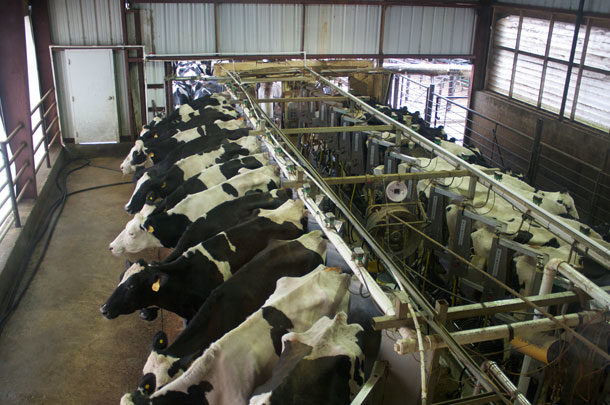During the 2015 National Mastitis Council meeting, Dr. Brandon Treichler, quality control veterinarian with Select Milk Producers, and Scott Hughes of Hughes Consulting Services, led an on-farm workshop to improve milk quality observation techniques.
A majority of the participants were veterinarians and consultants. This workshop was one of 10 short courses offered during the Feb. 1-3, 2015, meeting.
The dairy was located about an hour from the NMC meeting location in Memphis, Tennesee. Treichler and Hughes used the bus ride to provide advice to the group and tips for making evaluations at the dairy. An informational handout provided several details about the farm, including recent SCC records. The handout also featured teat and hygiene scorecards and detailed common milk quality benchmarks.
Overall approach
Treichler urged workshop participants to take a holistic view of the dairy without keying in on just one or two areas. It's important to talk to a variety of people on the dairy, he said, as the dairy manager or owner may not have all of the day-to-day management details.
When Treichler observes a dairy, he makes sure to visit every area.
"Many components of the dairy play into milk quality, and it’s important to see all the areas before coming to a diagnosis," he said. "As consultants, we have to determine not only what parts may be wrong according to some ideal, but we also need to determine which of those are actually contributing to the issue we are facing. Even though it may be a problem, that does not make it the problem."
He said it's important to ask open-ended questions to get the most insight about the operation. Reviewing records before the visit can help focus your questions and provide some early indicators of the problems facing the dairy.
"I try to go in skeptical," Treichler said. "I can't just believe what they think is happening. That's my job as a consultant."
He also advises that it will likely take several follow-up visits to determine the issues and work toward solutions with the producers. It is a mistake to believe that you can know what happens on a dairy after a single visit.
Look in areas others miss
Treichler advises leaving no stone unturned, and that may even include looking through the dairy's trash cans. That will reveal what products they're actually using and the way in which those products are handled. Are milking technicians wearing gloves? Are the proper dosages being followed? How clean are the used milk filters?
Other areas that tend to go unnoticed and therefore unserviced include: under the parlor curb or rotary deck, towel bins and bags, inside of teat dippers, inside inflations and shells, medicine storage, and milking implements, including extenders and teat plugs. All of these areas have the potential to harbor bacteria and pass that along through products like towels and teat dips that would likely otherwise be clean and applied to cows properly.
Parlor observation
In the parlor, consultants should watch for cow behavior at several key actions during milking: entrance to the parlor, at unit attach, at unit detach, any kick-offs and exit from the parlor. When observing milking technicians, consultants should pay attention to their attitudes and consistency when milking. It's important to watch not only how the technicians interact with the cows, but also how they interact with each other.
Benchmarks Treichler uses when evaluating the parlor include:
- Kick-offs below 5 percent of the herd
- Cows passing manure when entering the parlor are less than 3 percent
- Five percent or less unit reattachment, excluding kicked-off units
- Less than 5 percent liner squawks
When measuring equipment function, it's important to observe the vacuum gauge level and fluctuation, along with the regulator filters. The hose should not be too long or encounter any restrictions. Loops in hoses or uphill runs along with unit alignment all have an impact on the milk path. Torn liners or cups that are twisted to accommodate three-teat cows have caused dirt to get into pulsators.
Environment observation
Measure the freestalls if there is low utilization in the barns. The stalls could be too small or narrow for the cows. Observe the stall bed, including bedding type and depth. A common benchmark is to see less than 5 percent of stalls with visible manure contamination. Count cows and watch for overcrowding. Be sure not to overlook maternity pens and hospital areas.
The feedbunks and waterers should be evaluated for cleanliness. Determine the stocking density and available space. Feed should be present and pushed up, making it available for cows.
Alleys, crossovers and transfer lanes should all be observed too. Check the manure depth in these areas, and determine the method and frequency these areas are being cleaned.
"Pay special attention to what I call 'main street,' the pathway from the barn to the parlor," Treichler said. "This is a great place to observe for areas where cows can become splashed with manure from rapid cow movement or poorly cleaned transfer lanes."
Cow observation
The cleanliness of the cows can tell an observer a lot about the maintenance of facilities. Watch for lameness and consistent bumps or bruises on cows. Does what you're seeing from the cows match what you're hearing from the owner and employees? Does it match the farm's records?
"Many dairies have good intentions with setting protocols, but the daily follow-through isn't happening," Treichler said. "The cows are the best indication of what's actually being done." PD
PHOTO
A Mississippi dairy served as the location for the on-farm workshop during the National Mastitis Council meeting. Participants began practicing their milk quality observational skills from the farm's observation deck with a view of the parlor from above. Photo by Emily Caldwell.





